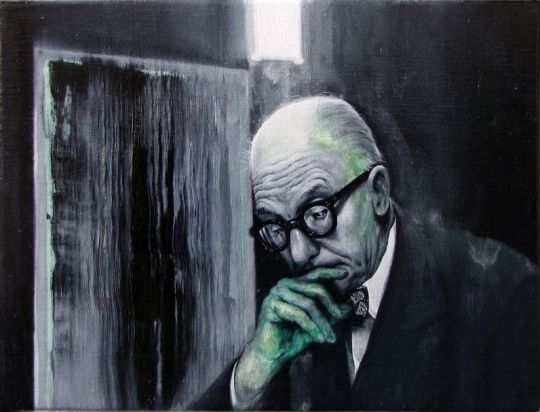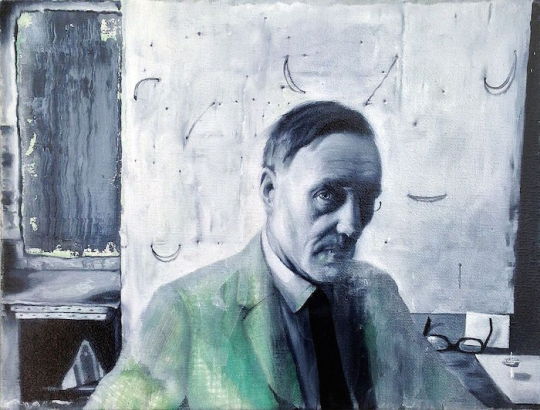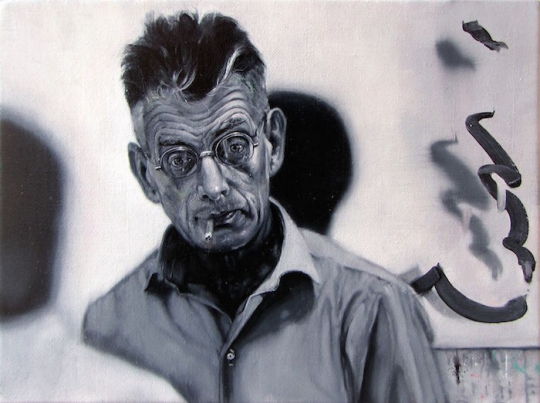Gavin Nolan’s latest exhibition at Charlie Smith London consists of recent paintings depicting versions of historical figures. The show runs from 14 April – 15 May. Combining hyper-realism with abstraction and mark making, his mostly intimate oil paintings reveal the heroic and fragile nature of the subjects and meditate on creativity, language, legacy and obsolescence. Focusing on iconic 20th century figures of note, Nolan’s current work examines his own relationship with the past. His interest in the inception of political, cultural and intellectual movements leads to an examination of their subsequent effects; and the echoes of an individual’s thoughts and actions that have moulded the modern period.

Artlyst: Your upcoming/current exhibition features historical figures. How do you go about choosing which subjects to paint?
GN:I see the figures as a gateway in to the past. For example, choosing to paint somebody related to the Modernist movement allows me to connect with ideas associated with that time and place. It’s apparent that today as a painter I can engage with subjects that seemed out of reach to me ten or fifteen years ago – there was much more of a prevailing wind in art.
Artlyst: Your work has a retro feel to it as it is based on 20th century photographic material. What was your defining moment in deciding to paint from this period?
GN:I think it came from pondering the notion of obsolescence. Painting to me always seems just outside of culture at large, and I think that has to do with how paintings exist as temporal objects, it’s a very slow form of media. So I was looking back at the post war period in western art where so many ideas and movements kept cropping up and then dying out, due in part to a linear, hierarchical approach to art history. One movement and idea surpassed by the next. But the objects that were made then are still slowly resonating with me. I needed to look back to be reminded of past possibilities that suggest a future. I’ve always loved Joseph Heller’s ‘God Knows’, where his King David reminisces on the key events of his life but through the prism of an understanding of life and time up to the 20th century.

Artlyst: How do you see your work progressing in terms of subject matter and application?
GN: I always want to expand the polarities within my work. Hyper-realism and material abstraction in the current work. How far can I push the space and still create something that functions as a painting? The palette choice comes down to a combination of the source material, which tends to be black and white, and the process, which is very traditional – terra verde under painting, then grisaille tones. Theoretically there should then follow a process of glazing colour and that might happen, but I want the work to exist in a provisional state, the incompleteness is important to me. I’ve considered being much more specific in terms of the type of paintings I depict within the work, transcribing the particular works that resonate with me.
Artlyst: Who are your seminal influences?
GN: Matisse in terms of where he placed the viewer, how he played with the gaze and seemed to bend space, and for his vibrancy. Picabia, an outsider on the inside. De Kooning, for redefining good and bad taste. Neo Rauch has made some incredibly complex paintings in the last decade.

Artlyst: Where do you see yourself in the next 20 years?
GN: I’ll be nearly sixty then, so if I make it… My wife and I, the artist Francesca Lowe, always talk of heading off to the countryside. I think we envisage some sort of artists idyll, living and working with our friends, maybe a regrouping of the Rockwell project but this time surrounded by green valley’s instead of pre-gentrified Dalston. Who knows? It could happen.
